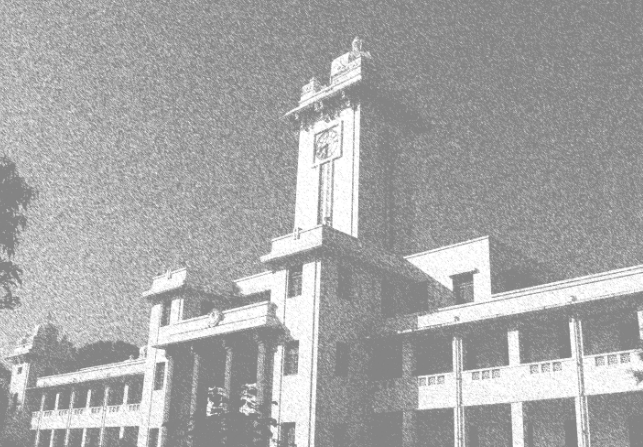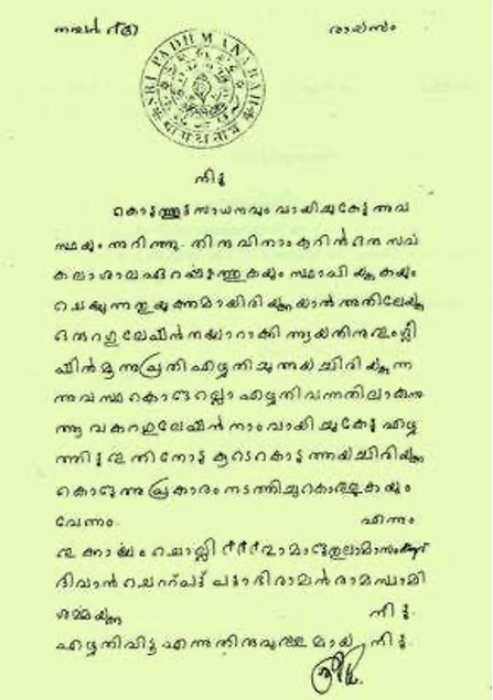The history of the University of Kerala is integral to the history of the state itself. One of the first 16 Universities in India, the University of Kerala was founded in 1937. It was formerly called the University of Travancore in the erstwhile princely state of Travancore (now southern part of Kerala and some neighbouring parts of state of Tamilnadu). The University came into being by a promulgation of the Maharajah of Travancore, Sri ChithiraThirunal Balarama Varma who was also the first Chancellor of the University. Sir C. P Ramaswamy Ayyar, the then Diwan (Prime minister) of the State was the first Vice-Chancellor. He was an eminent scholar and an able administrator. It is said that the Government made an unsuccessful attempt to invite Albert Einstein to be the first Vice-Chancellor. The University was modelled after the best Universities of the United Kingdom, and even today retains some of these features. The affiliating system of the University however evolved differently from the college system in British Universities.
The earliest origins of the University may be traced back to two institutions of modern learning in Kerala - the University College, Thiruvananthapuram and the Trivandrum Observatory. The University College was initially founded as the Maharaja's Free School by Maharaja Swathi Thirunal in 1834, with Mr John Roberts, a Christian Missionary as Headmaster, and soon grew into a college in 1866, affiliated to the Madras University. When the University of Travancore was founded, the departments of the college became University departments, only to switch back again when the transformation to University of Kerala happened in 1957. The University College still retains its connection with the University as an affiliated college. The Trivandrum Observatory was founded in 1838 and had an internationally reputed scientist, John Caldecott FRS as its first Director. It became a part of the Travancore University, but was administered as an independent government institution for some time. It is now the oldest institution under the Kerala University.
CAMPUSES
Ten colleges within the State of Travancore, which were at that time affiliated to the Madras University, became the affiliated colleges of the University of Travancore. In 1954, the unified state of Kerala came into being with most of Travancore, Cochin, and the Malabar area of the Madras presidency becoming part of it. The Kerala University Act (Act 14 of 1957) was brought into force and the University of Travancore was renamed University of Kerala. The University had three campuses located in three different parts of the State viz. Thiruvananthapuram, Ernakulam and Kozhikode. The number of affiliated colleges grew phenomenally. However, in 1968, the University Centre at Kozhikode became a full-fledged University, the University of Calicut, affiliating the colleges located in Thrissur, Palakkad, Kozhikode and Kannur districts of Kerala. The Cochin University of Science and Technology or CUSAT (1971), Kerala Agricultural University (1971) and Mahatma Gandhi University (1983) were subsequently established, with CUSAT taking over the University's centre at Cochin. These developments have shrunk the jurisdiction of the University of Kerala to Thiruvananthapuram, Kollam, Alappuzha Districts and some parts of Pathanamthitta District.
At present, the University has sixteen faculties and forty-four departments of teaching and research in addition to study centres and other departments. Teaching, research and knowledge extension are the mandates of the departments. They primarily focus on post-graduate (masters) programmes, MPhil programmes (1-year research degree) and doctoral research. (University's research activities are also going on in select affiliated colleges and other recognised research centres in and outside the state). The University has had as its faculty eminent scholars who were trained under legendary figures (Sir C. V. Raman's student in Dept of Physics, Prof S R Ranganathan's student in Library Science and Prof Benjamin Bloom's student in Dept of Education). Some of the faculty members themselves were legends, such as the renowned poet K Ayyappa Panciker and the Oriental Studies scholar T Ganapathi Sasthri among many others. The total number of full-time students in the University Departments is above 2000 including research students, along with a modest number of foreign students. The Institute of Distance Education offers a number of under-graduate and post graduate programmes which cater to more than 10,000 students, all over the country and abroad.

The University has also a number of study centres in specialised areas such as Nano-technology, Kerala Studies, Bioinformatics, Women's Studies, Learning Difficulties, Sree Narayana Studies, Gandhian Studies etc. Some of these centres have taught programmes (Certificate/Diploma/Masters/MPhil) and many offer PhD programmes. The University has also established 10 University Colleges of Teacher Education (UTEC) and 8 University Institute of Technologies (UIT) which offer under-graduate programmes (BEd in UTECs and BSc Computer Science/IT, Electronics/BBA in UITs), along with masters programmes available in select UITs. The University College of Engineering at Karyavattom offers Engineering Education at Undergraduate level. These institutions together have a student strength of more than 5000. The University has over 180 affiliated colleges. The role of the University is in prescribing courses of study and conducting examinations and issuing certificates. The day-to-day administration of these institutions is not under the purview of the University. However, these institutions form a major part of the University. There are 110 Arts and Science colleges, 7 Law colleges, 1 Engineering Colleges, 9 MBA, 4 MCA Colleges, 48 Teacher Training Colleges, 3 hotel management, 2 Fine Arts Colleges, 1 Music College and a fashion technology institute. The University also has a National College of Physical Education affiliated to it. The total number of students in these colleges crosses 95,000.

The University follows the Choice based credit and semester system for all post-graduate (Masters) programmes and is in the process of introducing this at under-graduate (Bachelors) level. Semesters typically fall during the months of Aug-January and February-July. The University has a very democratic system of functioning. Its supreme bodies -the Senate and Academic Council, have large number of elected members and students representatives. The executive body of the University, the Syndicate, also has a student representative (the first ever in Indian Universities, in 1977). The University policies are aimed at student empowerment in every field. The University Union is an active presence in the University life since 1939. University Study Centres have been set up with UGC assistance, at Kollam, Alappuzha and Pandalam, in order to help students who are not based in Thiruvananthapuram. Besides these, there are 13 Taluk Information Centres. The University also supplies information to students through the Help-desks in affiliated colleges. The Co-ordinator of the National Service Scheme Programme and the Director of the Student Services organize youth welfare activities with the active co-operation of the University Students' Union. The University bagged the Indira Gandhi National Award for the best NSS activities in 2005. Department of Physical Education of the University is in charge of all activities related to sports and games. It has gifted outstanding sportsmen and women to the country. The University stadium in the heart of the city has a world-class synthetic track. The University has a Main Library built near its city campus and caters to all students, staff and public. Alongside Department libraries and College libraries, there is also a Campus Library in the Karyavattom campus.

In addition to Departments, Centres and Affiliated colleges, the University has a number of other institutions under it. The UGC HRDC set up with the aid of the University Grants Commission, offers in-service courses to teachers in higher education and has trained over 15,000 teachers all over the country. It has been repeatedly rated the best in the country. The Centre for Adult & Continuing Education (CACEE) aims at 'further education of the educated' for which it received the UNESCO-NLM award for literacy in 2005. The Department of Publications, one of the oldest Departments of the University, has brought out several noteworthy publications including Saraswathi Kantabharanam, a treatise on Sanskrit Grammar; five volume Kerala Sahitya Charithram by Mahakavi Ulloor S. Parameswara Ayyar; Sahithya Nayakanmar (Men of Letters) Series; Chitra Ramayana, based on palm-leaf manuscripts; and the recent English and Malayalam translations of Hortus Malabaricus, the classical treatise on the plant wealth of Asia and the tropics. A massive Malayalam Lexicon is an ongoing project of the Lexicon Dept. Seven volumes of the proposed eleven-volume Malayalam Lexicon have been released so far and the editing work of the remaining four volumes is progressing. The University Computer Centre, which has a long history (back to the use of a Czech made Electro-Mechanical Computer Arithma in 1950s and Core-Memory based IBMs and Indian made TDC in 1970s), spearheads the University's e-Governance initiatives today. Computing support for research is no longer centralised, with the advent of affordable desk-top computing power. The University's main campus in Karyavattom is firmly connected to the cyber highway with broad-band connection flowing into hundreds of computers. The university website has also evolved since 2000 to become an indispensable cyber forum that connects the university community and serves information to all stake holders.
Here are some of the unique facts about the University of Kerala:
The University has been publishing the prestigious Journal of Indian History since 1946.
The Manuscript Library of the University is a treasure trove of archives on Indian culture. The library has over 65,000 works in 30,000 copies, mainly of palm leaf manuscripts, in addition to paper manuscripts,copper plates, writings on Bhurjapatra (birch bark), Agarutvak (the bark of Amyris agallocha) and textiles. The manuscript collection also includes those belonging to other Indian states and nations such as Burma, Malaysia, Indonesia, Nepal etc. About eighty per cent of the collections are in Sanskrit. The initial moulds of scripts of modern Indian languages like Bengali, Marathi, Gujarati, Kannada, Telugu, Oriya, Assamese and Burmese are also found.
The Centre for Adult & Continuing Education (CACEE) received the UNESCO- NLM award for literacy in 2005.
The first world Malayalam Conference was organised by the University of Kerala in 1977.
The University has honoured many scholars, scientists and technologists, artists and thought leaders with honorary degrees. Amartya Sen, K. J. Yesudas, Laurie Baker, Thakazhi Sivasankara Pillai, Bharatha Rathna M. S. Subbalakshmi, Semmangudi Sreenivasa Iyer, Harikesanallur Muthiah Bhagavathar, O. N. V. Kurup, G. Madhavan Nair, Chief Justice K. G. Balakrishnan, Ilya Prigogine, Dr. Jayant Narlikar, Prof. C.N.R. Rao are among the recipients.
The University Grants Commission has identified the University as one of the 26 institutions selected for promotion of India Studies by foreign students.
The University has been awarded an 'A++' grade by the National Assessment and Accreditation Council.
